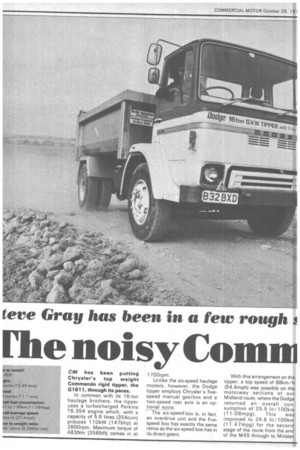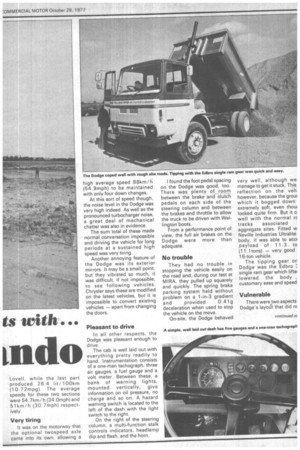[he noisy Comm
Page 36

Page 37

Page 39

If you've noticed an error in this article please click here to report it so we can fix it.
CM has been putting Chrysler's top weight Commando rigid tipper, the G1611, through its paces.
In common with its 16-ton haulage brothers, the tipper uses a turbocharged Perkins T6.354 engine which, with a capacity of 5.8 litres (354cuin) prduces 110kW (147bhp) at 2600rpm. Maximum torque of 483,1\1m (356Ibft) comes in at 170Orpm.
Unlike the six-speed haulage models, however, the Dodge tipper employs Chrysler's fivespeed manual gearbox and a two-speed rear axle is an optional extra.
The six-speed box is, in fact, an overdrive unit and the fivespeed box has exactly the same ratios as the six-speed box has in its direct gears.
With this arrangement on the tipper, a top speed of 88km / h (54.6mph) was possible on the motorway sections of our Midland route, where the Dodge returned an overall consumption of 25.5 lit/100km (11-08mpg). This was improved to 24.6 lit/100km (11.47mpg) for the second stage of the route from the end of the M45 through to Minster Lovell, while the last part produced 26.4 lit/100km (10.72mpg). The average speeds for these two sections were 54.7km /h (34.0mph) and 51km /h (30.7mph) respectively.
Very tiring
It was on the motorway that the optional twospeed axle came into its own, allowing a
high average speed 88km /1:i (54.9mph) to be maintained with only four down changes.
At this sort of speed though, the noise level in the Dodge was very high indeed. As well as the pronounced turbocharger noise, a great deal of mechanical chatter was also in evidence.
The sum total of these made normal conversation impossible and driving the vehicle for long periods at a sustained high speed was very tiring.
Another annoying feature of the Dodge was its exterior mirrors. It may be a small point, but they vibrated so much, it was difficult, if not impossible, to see following vehicles. Chrysler says these are modified on the latest vehicles, but it is impossible to convert existing vehicles — apart from changing the doors.
Pleasant to drive
In all other respects, the Dodge was pleasant enough to drive.
The cab is well laid out with everything pretty readily to hand. Instrumentation consists of a one-man tachograph, three air gauges, a fuel gauge and a volt meter. Between these, a bank of warning lights, mounted vertically, give information on oil pressure, no charge and so on. A hazard warning switch is located to the left of the dash with the light switch to the right.
On the right of the steering column, a multi-function stalk controls indicators, headlamp dip and flash, and the horn. I found the foot pedal spacing on the Dodge was good, too. There was plenty of room between the brake and clutch pedals on each side of the steering column and between the brakes and throttle to allow the truck to be driven with Wellington boots.
From a performance point of view, the full air brakes on the Dodge were more than adequate.
No trouble They had no trouble in stopping the vehicle easily on the road and, during our test at MIRA, they pulled up squarely and quickly. The spring brake parking system held without problem 011 a 1-in-3 gradient
and provided 0.41g deceleration when used to stop the vehicle on the move. On-site, the Dodge behaved very well, although we manage to get it stuck. This reflection on the veh however, because the grow which it bogged down extremely soft, even thou! looked quite firm. But it c! well with the normal rc tracks associated aggregate sites. Fitted w Neville Industries Ultralite body, it was able to aco payload of 11.3 to (11.1tons) — very good 16-ton vehicle.
The tipping gear or Dodge was the Edbro single ram gear which lifte, lowered the body , customary ease and speed Vulnerable
There were two aspects Dodge's layout that did rir it too well for site work, however.
The first was the mounting of the rear brake chambers, which looked very vulnerable, low down in front of the rear axle. Rough roads or large rocks could easily damage them. In the same way, the bottom of the radiator is protected by a very thin and pathetic looking guard and I doubt if it would last five minutes.
. But from a maintenance point of view, the Dodge must rate as one of the best. Access to the power unit and its ancillaries is very quick and easy with the one-man tilt cab which opens to 46'. When it is raised, all is revealed and the mechanic's task is made easy. The cab is held in the open position by an over centre stay, aided by two torsion bars.
Strong enough
This arrangement looks strong enough to retain the cab even in high winds. To allow full tilting, a universal joint is incorporated in the steering column just above the box itself. For day-to-day checks of oil and water, there is no need to tilt the cab. Oil is checked via a small hinged lid on the engine cover in the cab, while the water header tank is located at the back of the 'cab.
Our test vehicle was fitted with the Hi-line specification cab — indicating a higher standard of trim — and a dual passenger seat. With this arrangement it was necessary to move the seat to lift the oil checking flap — not the best set-up if a quick check is required.
Fluid level for the clutch is inspected by lifting a flap on the dash top and the electrical system fuses are situated to the right of the steering column.
Summary
Overall, the Dodge, with its excellent payload capacity, good fuel consumption and well laid out cab is a good vehicle for site work. But Chrysler really must do something about the noise from the power unit. Running around site and on short hauls, it doesn't present a problem, but on a long run, it is unacceptable.
Apart from this, the Chrysler performed well on our test and should give good service for the operator needing a middle weight tipper. Basic price of the Dodge chassis cab is £10,378. With the Ultralite body, twospeed axle, Hi-line trim and dual passenger seat the total was £12,969 as tested.




















































































































